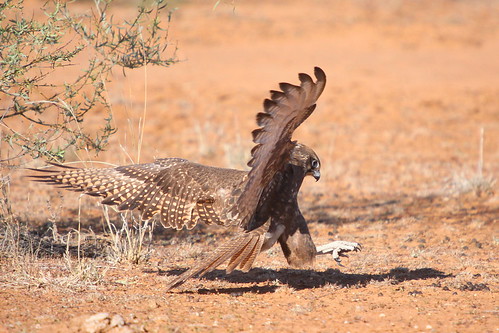 Bowra Station is justifiably known as one of Australia's 'birding hotspots'. Formally privately owned by a couple who encouraged birdwatchers, it is in the process of being purchased by the Australian Wildlife Conservancy using a combination of government grants and private donations. Not all of the Conservancy's properties are regularly open to visitors so birders are anxiously waiting to see what the policies will be at Bowra.
Bowra Station is justifiably known as one of Australia's 'birding hotspots'. Formally privately owned by a couple who encouraged birdwatchers, it is in the process of being purchased by the Australian Wildlife Conservancy using a combination of government grants and private donations. Not all of the Conservancy's properties are regularly open to visitors so birders are anxiously waiting to see what the policies will be at Bowra.The afternoon we arrived was heavily overcast, making conditions difficult for bird photography. We settled down beside the homestead lagoon to watch large flocks of ibis test out various trees for suitability as a night time roost. They eventually decided against this spot, and all flew off into the dusk. We had some light rain over night, but the next day dawned clear.
Around the homestead and its lagoon were ibis, stilt, ducks, heron, dotterel, swallows, flycatchers, woodswallows, babblers, tree creepers, parrots and an active bowerbird bower. No sign of the Grey Falcon which reportedly visits the home lagoon, but it had not been seen for some weeks - since the young fledged.
We went out to Sawpits Waterhole spotting Bourke's Parrots just where the sign said they would be under the mulga, and watching a Spotted Bowerbird take a lengthy bath. Ringnecks were involved in a noisy courtship routine, and the whistlers' loud, melodious song was heard along the banks. Honeyeaters defended choice clumps of eucalypt blossoms.
Near the Main Creek crossing we pursued Halls and Grey-crowned Babblers, waiting for them to sit still long enough to have their portrait taken. The Button Quail didn't hang about either. The dozens of woodswallows searching for insects on the eucalypts were more obliging. A juvenile even came and sat near us on the ground, presenting several angles to ensure a flattering image.
At Stony Lookout we saw two Chestnut-breasted Quail Thrush, and in following them came across a Red-backed Kingfisher and male and female Red-capped Robins, and Slaty-backed Thornbills. We could hear the Crested Bellbird but could not locate it.
Back at the homestead to pack up camp, Chestnut-crowned Babblers searched for insects at the edge of the lagoon, and a Restless Flycatcher hovered over the water.
Bird List:
Grey Teal
Hardhead
Australian Wood Duck
Pacific Black Duck
Australian Pelican
Little Black Cormorant
Australasian Darter
White-necked Heron
Great Egret
Straw-necked Ibis
Yellow-billed Spoonbill
Royal Spoonbill
Whistling Kite
Wedge-tailed Eagle
Black-shouldered Kite
Black Kite
Nankeen Kestrel
Brown Falcon
Australian Hobby
Little Button-quail
Black-tailed Native-hen
Common Bronzewing
Diamond Dove
Crested Pigeon
Peaceful Dove
Little Corella
Galah
Major Mitchell's Cockatoo
Mallee Ringneck
Blue Bonnet
Red-winged Parrot
Red-rumped Parrot
Bourke's Parrot
Mulga Parrot
Budgerigar
Laughing Kookaburra
Red-backed Kingfisher
Sacred Kingfisher
Brown Honeyeater
White-plumed Honeyeater
Little Friarbird
Yellow-throated Miner
Singing Honeyeater
Noisy Friarbird
Spiny-cheeked Honeyeater
Striped Honeyeater
Black-faced Cuckoo-shrike
White-winged Triller
Australian Raven
Welcome Swallow
Tree Martin
Fairy Martin
Willie Wagtail
Jacky Winter
Red-capped Robin
Crested Bellbird
Rufous Whistler
Grey-crowned Babbler
Hall's Babbler
Chestnut-crowned Babbler
White-winged Fairy-wren
Splendid Fairy-wren
Inland Thornbill
Slaty-backed Thornbill
Southern Whiteface
White-browed Treecreeper
Brown Treecreeper
Magpie-lark
White-winged Chough
Apostlebird
White-breasted Woodswallow
White-browed Woodswallow
Masked Woodswallow
Black-faced Woodswallow
Little Woodswallow
Grey Butcherbird
Pied Butcherbird
Australian Magpie
Spotted Bowerbird
Australasian Pipit
Zebra Finch

No comments:
Post a Comment